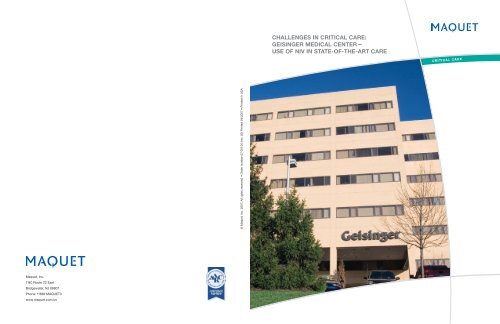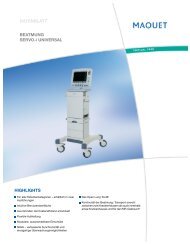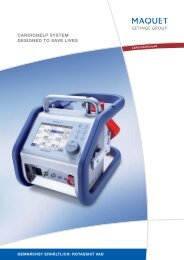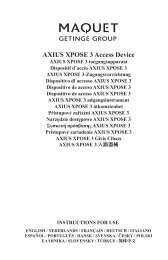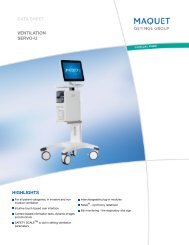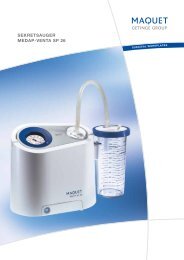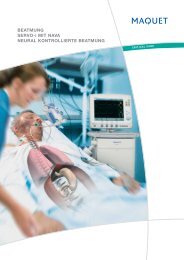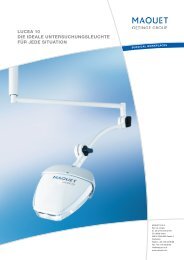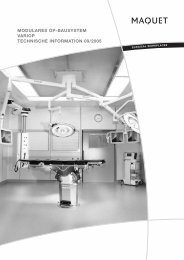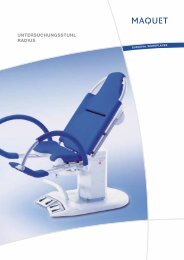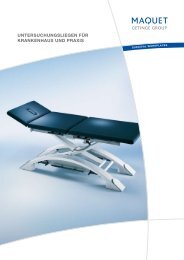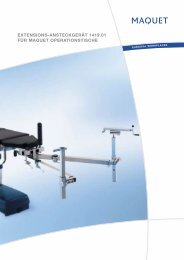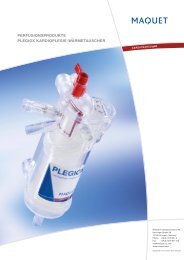challenges in critical care: geisinger medical center - Maquet
challenges in critical care: geisinger medical center - Maquet
challenges in critical care: geisinger medical center - Maquet
Create successful ePaper yourself
Turn your PDF publications into a flip-book with our unique Google optimized e-Paper software.
<strong>Maquet</strong>, Inc.<br />
1140 Route 22 East<br />
Bridgewater, NJ 08807<br />
Phone: 1-888-MAQUET3<br />
www.maquet.com/us<br />
© <strong>Maquet</strong>, Inc. 2007. All rights reserved. • Order number 07 001 05 (rev: 00) Pr<strong>in</strong>ted 04/2007 • Pr<strong>in</strong>ted <strong>in</strong> USA<br />
CHALLENGES IN CRITICAL CARE:<br />
GEISINGER MEDICAL CENTER—<br />
USE OF NIV IN STATE-OF-THE-ART CARE
| 2 | Geis<strong>in</strong>ger Hospital | Critical Care |<br />
WORLD-RENOWNED MEDICAL CENTER SERVING CENTRAL AND<br />
NORTHEASTERN PENNSYLVANIA FINDS NIV OPTION ON SERVO-i<br />
VENTILATORS VALUABLE TREATMENT ALTERNATIVE.<br />
GEISINGER MEDICAL CENTER<br />
SERVO-i <strong>in</strong> use at bedside<br />
For more than 90 years, Geis<strong>in</strong>ger Medical Center<br />
<strong>in</strong> Danville, Pennsylvania, has been known as the<br />
region’s resource for the highest quality health<strong>care</strong>.<br />
Its physicians, all of whom are connected by a sophisticated<br />
electronic <strong>medical</strong> record system, practice <strong>in</strong> more than 75<br />
<strong>medical</strong> specialties. Thanks to its highly regarded expertise<br />
and its use of the most advanced technology <strong>in</strong> the country,<br />
the most complex cases <strong>in</strong> Central and Northeastern<br />
Pennsylvania often are referred to the 437-bed <strong>medical</strong> <strong>center</strong>.<br />
As one of the nation’s top <strong>medical</strong>/surgical and Level 1 trauma<br />
<strong>center</strong>s with supplementary accreditation <strong>in</strong> pediatrics,<br />
Geis<strong>in</strong>ger must have state-of-the-art equipment and procedures<br />
for acutely ill patients. For patients with acute respiratory<br />
illnesses, the hospital has a fleet of 45 SERVO-i ventilators.<br />
It recently upgraded its fleet to <strong>in</strong>clude software for non<strong>in</strong>vasive<br />
(NIV) functionality.<br />
NIV is a valuable treatment alternative for acute hypercapneic<br />
respiratory failure, particularly <strong>in</strong> patients with chronic<br />
obstructive pulmonary disease (COPD). The hospital sees many<br />
COPD patients, particularly among its elderly patient population,<br />
says John Conrad, BS, RRT-NPS, RCP, Adm<strong>in</strong>istrative Team<br />
Leader for the Respiratory Care Services. Also, NIV can be<br />
effective <strong>in</strong> cardiogenic pulmonary edema (CPE) as well as<br />
dur<strong>in</strong>g wean<strong>in</strong>g, he says.<br />
Non-<strong>in</strong>vasive ventilation helps avoid some of the complications<br />
that can be associated with <strong>in</strong>vasive ventilation, such as<br />
discomfort, <strong>in</strong>fections and airway trauma. NIV also can shorten<br />
hospital stays for select patients, reduc<strong>in</strong>g their treatment costs,<br />
Conrad says.<br />
SERVO trend<strong>in</strong>g package makes monitor<strong>in</strong>g set<br />
pressure for patients on NIV easy. As a Respiratory<br />
Therapist, Mark Reffner, BS, RRT, RCP, f<strong>in</strong>ds the NIV option<br />
on the SERVO-i easy to employ. Dur<strong>in</strong>g NIV, the ventilator<br />
automatically adapts to variations <strong>in</strong> leakage to ma<strong>in</strong>ta<strong>in</strong> the<br />
required pressure and positive end-expiratory pressure (PEEP)<br />
level, he says. The leakage percentage is one of the values<br />
displayed under trends, mak<strong>in</strong>g it easier to make adjustments<br />
as needed. “It is possible, by measur<strong>in</strong>g and adjust<strong>in</strong>g dur<strong>in</strong>g<br />
the same breath, to ma<strong>in</strong>ta<strong>in</strong> the set pressure to the patient,”<br />
he says.<br />
Jennifer M. Small, RRT, RCP, Adult Critical Care Team Leader,<br />
f<strong>in</strong>ds most patients tolerate NIV extremely well, especially if they<br />
are relaxed. To make patients comfortable, she often holds the<br />
facemask <strong>in</strong> place for a few m<strong>in</strong>utes before strapp<strong>in</strong>g it on.<br />
The SERVO-i ventilator does not require any proprietary <strong>in</strong>terface.<br />
Many masks and harnesses are available <strong>in</strong> several designs<br />
and materials as patients have different facial contours.<br />
To standardize <strong>care</strong>, Geis<strong>in</strong>ger has adopted protocols for how<br />
supportive therapy is <strong>in</strong>itiated, ma<strong>in</strong>ta<strong>in</strong>ed, and discont<strong>in</strong>ued<br />
to alleviate a patient’s work of breath<strong>in</strong>g, and to ensure adequate<br />
oxygenation and ventilation. The overall goal of Geis<strong>in</strong>ger’s<br />
ventilator management protocol is to have all patients on<br />
mechanical ventilation for the shortest time possible. This helps<br />
reduce the <strong>in</strong>cidence of Ventilator Associated Pneumonias<br />
(VAP), s<strong>in</strong>ce patients who are <strong>in</strong>tubated greater then forty-eight<br />
hours are more susceptible to VAP. Patients are assessed<br />
at least every four hours, and a wean is attempted based<br />
on the patient’s tolerance and criteria listed <strong>in</strong> the Geis<strong>in</strong>ger<br />
Ventilation Management Protocol. Patient <strong>in</strong> a facemask for non-<strong>in</strong>vasive ventilation<br />
| Critical Care | Geis<strong>in</strong>ger Hospital | 3 |<br />
Geis<strong>in</strong>ger’s protocol is based on the ARDSnet protocol, and<br />
was developed by their Pulmonary and Adult Critical Care<br />
physicians. The protocol allows the therapists to use their<br />
knowledge and expertise to <strong>care</strong> for <strong>in</strong>vasively and non<strong>in</strong>vasively<br />
mechanically ventilated patients. A section of its<br />
Respiratory Care Services Manual, Ventilation Management<br />
Protocol, addresses non-<strong>in</strong>vasive, positive pressure ventilation<br />
(NPPV). The RTs on staff are well respected, and work closely<br />
with physicians <strong>in</strong> f<strong>in</strong>d<strong>in</strong>g the right sett<strong>in</strong>gs and appropriate<br />
mode of ventilation for patients who need assistance breath<strong>in</strong>g,<br />
Small says. Hav<strong>in</strong>g the SERVO-i ventilators makes deliver<strong>in</strong>g<br />
the most appropriate, state-of-the-art <strong>care</strong> for each patient<br />
possible, she says.
| 4 | Geis<strong>in</strong>ger Hospital | Critical Care |<br />
Mach<strong>in</strong>e’s dual capabilities help staff ma<strong>in</strong>ta<strong>in</strong><br />
patient’s comfort level. A key advantage of the SERVO-i<br />
for Geis<strong>in</strong>ger is that it has <strong>in</strong>vasive and non-<strong>in</strong>vasive capabilities<br />
<strong>in</strong> one mach<strong>in</strong>e, requir<strong>in</strong>g less space <strong>in</strong> its patient rooms.<br />
“NIV has always been available, but on separate units,” Conrad<br />
expla<strong>in</strong>s. “Space <strong>in</strong>side the patient rooms on the <strong>critical</strong> <strong>care</strong><br />
floors can be an issue. With the bed and all the monitor<strong>in</strong>g<br />
equipment, the IV poles, the cords and everyth<strong>in</strong>g else, hav<strong>in</strong>g<br />
one mach<strong>in</strong>e that can be used for <strong>in</strong>vasive as well as non<strong>in</strong>vasive<br />
is a def<strong>in</strong>ite plus. You no longer have to push the<br />
<strong>in</strong>vasive unit to the back or out of the room if you wish to<br />
switch modes.”<br />
Anecdotally, the hospital has found that because it now<br />
has NIV capabilities so readily available, it has reduced the<br />
number of patients it has had to re-<strong>in</strong>tubate. “We use NIV if you<br />
extubate a patient and he or she still needs some additional<br />
support,” Reffner says. “You can use NIV to bridge the gap,<br />
and you end up not hav<strong>in</strong>g to re<strong>in</strong>sert the endotracheal tube.”<br />
NIV also is useful for ventilated patients who must wait a few<br />
days for a follow-up surgical procedure, Reffner says. “You may<br />
extubate a patient but he or she is go<strong>in</strong>g to have to go back<br />
to surgery a few days later. You can put them on non-<strong>in</strong>vasive<br />
ventilation and give them a little break periodically. A little time<br />
on the mask, a little time off the mask. They are more<br />
comfortable and don’t have to have an endotracheal tube<br />
lead<strong>in</strong>g up to their second surgery.”<br />
Reffner also has seen patients weaned from mechanical<br />
ventilation with an endotracheal tube earlier, because the<br />
staff knows that NIV is there to support patients if needed<br />
when they are ready to be extubated.<br />
Hav<strong>in</strong>g one ventilator with non-<strong>in</strong>vasive capabilities<br />
is cost-effective, too. The hospital also realizes cost sav<strong>in</strong>gs<br />
from hav<strong>in</strong>g NIV capabilities on its SERVO-i ventilator fleet.<br />
“In the past, we would be runn<strong>in</strong>g so many NIVs that we had<br />
to rent mach<strong>in</strong>es,” Conrad says. “Hav<strong>in</strong>g the SERVO-i ventilators<br />
with NIV capabilities prevents us from need<strong>in</strong>g to rent additional<br />
mach<strong>in</strong>es, which can be costly.”<br />
Because of the transport capabilities of the SERVO-i, patients<br />
who require NIV <strong>in</strong> the ER can be more easily transferred to<br />
the ICU if and when they are admitted. With the SERVO-i, their<br />
NIV can be ma<strong>in</strong>ta<strong>in</strong>ed dur<strong>in</strong>g transport, Reffner notes.<br />
One of the reasons Geis<strong>in</strong>ger purchased the SERVO-i ventilators<br />
was its evaluation team liked that the mach<strong>in</strong>es could be<br />
upgraded to meet its chang<strong>in</strong>g needs and advances <strong>in</strong><br />
respiratory technology. Be<strong>in</strong>g able to upgrade to <strong>in</strong>clude NIV<br />
software has been a real plus. Says Conrad: It only confirms<br />
the orig<strong>in</strong>al decision to choose the SERVO-i.<br />
Mark Reffner, BS, RRT, RCP,<br />
Respiratory Therapist<br />
Jennifer M. Small, RRT, RCP<br />
Adult Critical Care Team Leader<br />
John Conrad, BS, RRT-NPS, RCP, Adm<strong>in</strong>istrative Team<br />
Leader for the Respiratory Care Services<br />
Guidel<strong>in</strong>es:<br />
Patient Assessment:<br />
1. Any acutely ill patient must be evaluated for adequacy of his/her<br />
native airway. Level of consciousness, respiratory pattern and rate,<br />
breath sounds, upper airway patency, secretion control, etc., are<br />
parameters to be assessed. A patent airway can be established<br />
by suction<strong>in</strong>g removal of foreign bodies, jaw thrust, ch<strong>in</strong> lift,<br />
oropharyngeal airway, nasopharyngeal airway, and/or <strong>in</strong>tubation.<br />
However, most <strong>critical</strong>ly ill patients require <strong>in</strong>tubation.<br />
When <strong>in</strong>tubation is done <strong>in</strong> emergent situations, the senior most<br />
person who possesses the necessary <strong>in</strong>tubation skills should<br />
supervise and/or perform this procedure. For any patient requir<strong>in</strong>g<br />
<strong>in</strong>tubation, before <strong>in</strong>tubation is attempted, a nasogastric tube<br />
should be <strong>in</strong>serted to empty gastric contents and/or cricoid<br />
pressure should be applied <strong>in</strong> order to m<strong>in</strong>imize the risk of<br />
aspiration of these contents. Also, a patient’s respiratory efforts<br />
should be controlled. This can be accomplished by oxygenat<strong>in</strong>g<br />
and hyperventilat<strong>in</strong>g a patient with a mask device attached to a<br />
supplemental oxygen source (usually FiO = 100%). An oral airway<br />
may help facilitate “bagg<strong>in</strong>g.” Adequate sedation and topical<br />
anesthesia should be used prior to attempt<strong>in</strong>g <strong>in</strong>tubation.<br />
Respiratory therapist car<strong>in</strong>g for patient on non-<strong>in</strong>vasive<br />
ventilation with the SERVO-i<br />
Excerpts from Geis<strong>in</strong>ger Health System Mechanical Ventilation Protocol<br />
| Critical Care | Geis<strong>in</strong>ger Hospital | 5 |<br />
Chemical paralysis may be needed, but only with the approval<br />
of a staff physician. When used, sedation should always precede<br />
paralysis and must be ma<strong>in</strong>ta<strong>in</strong>ed while paralysis persists.<br />
Only after gastric contents have been evacuated and adequate<br />
airway control, oxygenation, and appropriate patient relaxation<br />
have been achieved should <strong>in</strong>tubation be attempted. If a patient<br />
has been heavily sedated and/or paralyzed, mechanical ventilation<br />
will be necessary. After <strong>in</strong>tubation, endotracheal tube placement<br />
can be confirmed by visibly check<strong>in</strong>g the placement of the<br />
endotracheal tube (should be between the vocal cords), listen<strong>in</strong>g<br />
for bilateral breath sounds, look<strong>in</strong>g for mist<strong>in</strong>g <strong>in</strong> the endotracheal<br />
tube, CO2 detection, chest X-ray and/or bronchoscopy <strong>in</strong><br />
some cases.<br />
2. The adequacy of an acutely ill patient’s respiratory activity needs<br />
to be assessed. Though arterial blood gases, pulse oximetry,<br />
and end-tidal CO2 are commonly relied upon, they should not be<br />
the sole <strong>in</strong>dicators of a patient’s respiratory activity. Other<br />
<strong>in</strong>dicators are a patient’s rate, depth and pattern of respiratory<br />
activity, mental status, and overall ‘comfort’ level.<br />
(cont<strong>in</strong>ued)
| 6 | Geis<strong>in</strong>ger Hospital | Critical Care |<br />
Guidel<strong>in</strong>es:<br />
NPPV (Non-Invasive Positive Pressure Ventilation)<br />
1. Initiation of NPPV<br />
a. In conjunction with section B:<br />
Patient Assessment, a spontaneously breath<strong>in</strong>g patient<br />
with two of the follow<strong>in</strong>g criteria may be a candidate<br />
for NPPV:<br />
1. dyspnea<br />
2. accessory muscle use<br />
3. SaO < 90%<br />
4. respiratory rate > 24 BPM<br />
b. A patient with the follow<strong>in</strong>g is not a candidate for NPPV:<br />
1. respiratory arrest<br />
2. uncontrolled arrhythmia<br />
3. airway obstruction<br />
4. <strong>in</strong>ability to clear secretions<br />
5. coma, uncooperative or claustrophobia<br />
6. facial trauma<br />
7. hypotension with systolic blood pressure<br />
< 90 mmHg<br />
c. Initial sett<strong>in</strong>gs <strong>in</strong>clude:<br />
1. NIV-Pressure Support<br />
2. Pressure Support Level = 10cmh20<br />
3. PEEP = 4 cmh20<br />
4. backup rate=8 BPM<br />
5. <strong>in</strong>spiratory rise adjusted to patient comfort.<br />
Note: A comfortable, properly fitt<strong>in</strong>g mask should be chosen, too.<br />
d. To adjust for optimal ventilation, <strong>in</strong>crease PS <strong>in</strong> <strong>in</strong>crements<br />
of 2 cm H2O to relieve respiratory distress, and to adjust for<br />
<strong>in</strong>adequate oxygenation, <strong>in</strong>crease PEEP (<strong>in</strong> <strong>in</strong>crements of 2 cm<br />
H2O) and/or FiO to achieve SaO > 92%. Note: Increases <strong>in</strong> PEEP<br />
will decrease PS. Therefore, PS may have to be <strong>in</strong>creased to<br />
ma<strong>in</strong>ta<strong>in</strong> desired ventilation.<br />
2. Discont<strong>in</strong>uation of NPPV<br />
a. When precipitat<strong>in</strong>g cause(s) of respiratory failure is/are sufficiently resolved, when m<strong>in</strong>imal NIV support (PS and PEEP) pressures are<br />
needed to ma<strong>in</strong>ta<strong>in</strong> adequate patient comfort without signs/symptoms of respiratory distress, and when FiO < 65%, a trial off NPPV<br />
can be <strong>in</strong>itiated. Note: M<strong>in</strong>imal NIV support pressures are: PS = 10 cm H2O and PEEP=4 cm H2O. The views, op<strong>in</strong>ions, and assertions stated by Geis<strong>in</strong>ger Medical<br />
Center staff members <strong>in</strong> this article are strictly those of the<br />
cl<strong>in</strong>icians and adm<strong>in</strong>istrators, and do not necessarily reflect the<br />
views of MAQUET.


